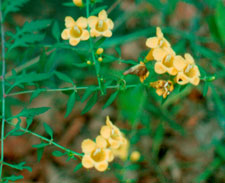Resource Library
Plant of the Week: Wild Foxglove
The University of Arkansas System Division of Agriculture does not promote, support or recommend plants featured in "Plant of the Week." Please consult your local Extension office for plants suitable for your region.
Plant of the Week
Wild Foxglove
Latin: Aureolaria flava Gerardia

As anyone who has done genealogical research knows, names have a way of changing. Plant names also change, often with maddening frequency. One plant with a new name, Gerardia or yellow false foxglove (Aureolaria flava), is in bloom in woodlands throughout Arkansas.
Gerardia is a three- to five-foot tall open, sprawling perennial growing in association with oaks. It is a hemiparasite - a plant that obtains some of its nutrients from the oaks it parasitizes, but carries on its own photosynthesis. It shuns heavy shade, favoring open woodlands or disturbed areas along roadways. It ranges throughout the eastern woodlands as far north as Canada.
Leaves on the lower part of the plant are dissected like those of Vitex, but towards the ends of the branches become entire, willow-like but only half as long as those lower on the plant.
Gerardia produces thumb sized yellow, five-lobed funnel shaped flowers at the ends of the branches during late summer. They have a wide-open throat and are, like many other members of the figwort family, pollinated primarily by bumble bees.
Though this is a lovely wildflower, I’ve never seen Gerardia grown in a garden. Its parasitic ways make growing it a challenge. I read of one Missouri botanist claiming to have kept it alive after transplanting an established plant, but such reports are rare. It is best enjoyed in the wild.
The genus name Gerardia was given to this plant by Linnaeus in 1753 to commemorate John Gerard (1545 - 1612). Gerard is remembered for his Herbal or General History of Plants that first appeared in 1597. This was the era when botany was a branch of medicine and herbals were the doctor’s desk reference used to cure patients. His was the first to appear in English instead of the more traditional Latin.

Gerard would never have made it in the modern world. His herbal is reported to be plagiarized from a French work published in 1585 that was translated by - as he says in the introduction by a “Doctor Priest, one of our London colleagues .... (who) meant to publish the same, but being prevented by death.” The hundreds of ornate woodcuts used to illustrate the work were mostly taken from a German herbal of the period.
Authors of herbals freely copied works from one another and past writers. Many of the remedies Gerard reports on are attributed directly to early Greek writers such as Theophrastus and Aristotle, but he adds bits of English folkways to make it a valuable reference. Intellectual property writes is a relatively new concept dating from the 19th century.
The volume I have is the 1975 Dover reprint of the 1633 second edition prepared by Thomas Johnson in the span of just a year. This edition describes 2,800 plants and adds 800 additional woodcut illustrations to the work, stretching its length to 1,650 pages. It includes a number of New World plants and reports, in its quaint Old English style, what gardeners are growing 400 years ago.
By: Gerald Klingaman, retired
Extension Horticulturist - Ornamentals
Extension News - October 6, 2006
The University of Arkansas System Division of Agriculture does not maintain lists of retail outlets where these plants can be purchased. Please check your local nursery or other retail outlets to ask about the availability of these plants for your growing area.